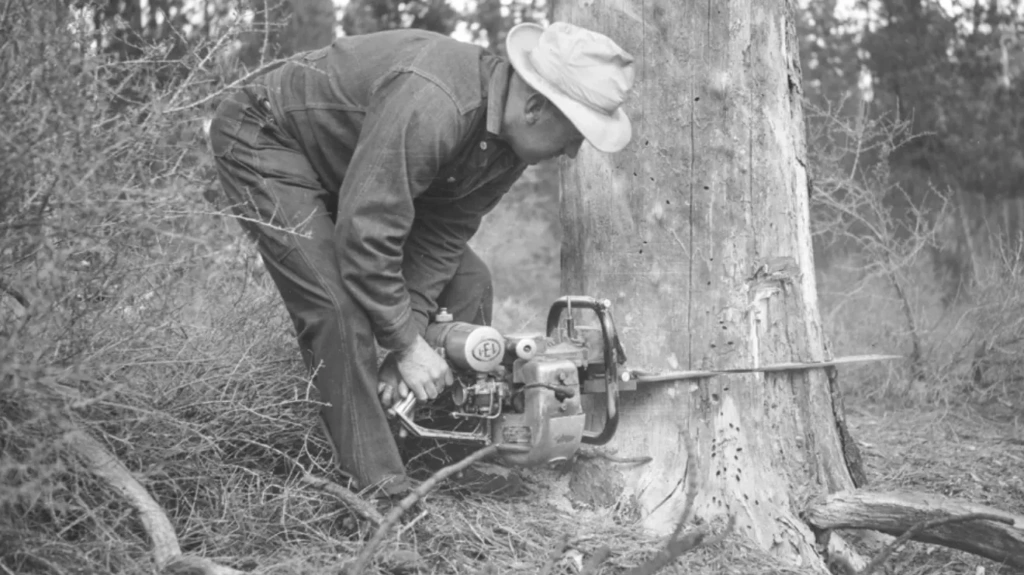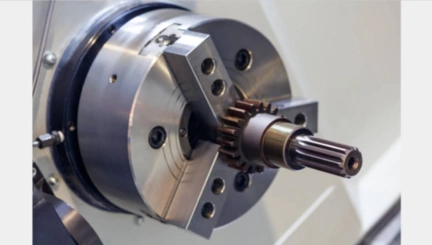- 11min
- 16108
- 0
Did you know that the original use of a chainsaw was in surgical operations? When do you think this versatile power tool first found its way to the world of cinema? Any ideas on Which conflict triggered a boom in the production of portable chainsaws?
The history of the chainsaw is a fascinating one, filled with progress, change and a lasting impact on popular culture.
Searching for an excellent chainsaw supplier with exciting offers?

Keep reading to discover why chainsaws were invented in the first place and delve into all the interesting facts you need to know about this popular cutting tool.
Chainsaw Fever: What’s all the fuss about?
A chainsaw is a portable gasoline, electric, or battery powered saw which cuts through various materials relying on a set of teeth attached to a rotating chain driven along a guide bar. It is a versatile tool that finds application in a wide range of activities including tree felling, limbing, bucking, pruning, cutting firebreaks in wildland fire suppression efforts and harvesting firewood.

Chainsaws with specially designed bar and chain combinations have also been developed as tools for chainsaw art and chainsaw mills. Over the decades, these specialized saws have significantly increased timber production compared to the era when non-motorized saws and axes were the norm.
Let’s see what led to the chainsaw invention and explore how this versatile cutting tool has evolved over the years.
Why Were Chainsaws Invented?

Unlike what you might believe, the original use of a chainsaw was not related to cutting trees and lumbers. These cutting tools were first made to be used during bone surgery, amputations and childbirth.
While the history of chainsaw invention goes back to the surgery room, it toddled its first steps in war zones and even made their debut on the silver screen!
On The Front Lines

As a lesser-known chapter in chainsaw history book, the lightweight and portable version of this cutting tool was mass produced during World War II. Soldiers used chainsaws to clear their path through dense vegetations and other obstacles on the battlefield.
Cinematic Debut

After auditioning so many times, chainsaw finally secured a role in a movie! It was in 1974 horror movie named “The Texas Chainsaw Massacre” that this cutting tool first appeared on the silver screen. It is now the symbol of fear and pain in the horror genre and a regular in slasher movies.
Tree Surgeon’s Assistant
Although healthcare system and military services have a claim on the original use of a chainsaw, this cutting tool gradually evolved into one of the major tools used in forestry.
When it comes to trees and woodworking, A growing demand for timber coupled with a desire for a faster and more efficient tree-cutting method that would minimize waste, was the main reason why chainsaws were invented.

Chainsaws have left a paramount impact on the timber and forestry industries. Although today we take them for granted, our ancestors collected wood using axes and other heavy objects which was a laborious and time-consuming procedure. that was their reality, from antiquity until the conception of the first modern chainsaw.
How Was It Like Before Chainsaws?
Axe has the longest history among all the wood cutting tools used by humans. Its application goes so far back in human history and its evolving form from stone, copper and bronze to iron, reflects the diversity of the cultures it was a part of. Axe remained one of the most important and widely used tools for felling trees well into the 19th Century.
Around 5000 B.C., Germanic tribes invented the first saw. They nicked small teeth into half-moon shaped flints. Whether these saws were used for working on wood is not known. After the discovery of copper this was used, in the form of bronze, to produce axes and saws (with axes not only could trees be felled, but also adversaries). Around 750 B.C., iron replaced bronze but saws remained out of bronze for artisans, doctors and surgeons rather than lumberjacks.

There’s limited historical information on other uses of the saw up until the 8th Century A.C. From this time on, they were used by artisans but not by lumberjacks. Up until the 16th Century there is no proof, that hand saws were used in forestry work. In contrast, sawmills, designed to cut trunks into planks, had already been in operation in wooded areas.
Around 1500, Leonardo da Vinci also sent made significant contributions to saw technology. He sketched – as far as is known – the first saw teeth which worked both by pulling and pushing. Prior to that, these cutting tools either worked by pushing (Europe) or by pulling (Asia).

Around 1800 the first circular and band saws were produced in England. At this time there was still a division of work between the axe and the saw: the felling and debranching was carried out using an axe, and saws were used for the cutting to length. Saws kept their inferior rule for a long time. To some extent the saw was unknown by many and in certain places it was forbidden to use saws for felling trees.
In 1752, Empress Maria Theresa, archduchess of Austria and queen of Hungary and Bohemia, decreed trees should no longer be felled “in the old way with the chopper, but with the saw near to the roots” to reduce timber waste and improve fertilization (saw dust decomposes quicker than wood shavings).
This decree, however, was disregarded like many others was ignored partly because, at that time, lumberjacks weren’t used to kneeling down while working. On top of that, saws were about six times more expensive than axes. Lumberjacks could not afford them, so employers provided them, changing lumberjacks’ status from self-employed artisans to wage workers. Timber thieves however preferred the saw because they produced less noise. Consequently, those caught stealing timber with saws faced harsher penalties

Although saws were already known in antiquity (Egypt, Rome), they were only widely put into use in the central Europe’s Forest industry in the mid-18th Century.
The saw brought not only an increased yield in timber but also many other advantages for forestry owners. However, for the lumberjacks, the advent of saws came with nothing but disadvantages.
In the middle of the 19th Century, some forward-looking individuals built mechanical saws like drag saws that could be taken into the forests. Unfortunately, most of these inventions were very heavy, unwieldy or never really progressed beyond the prototype stage. The same happened to machines powered by steam engines, fueled with the resulting wood waste.
When Was the Chainsaw First Invented? And by who?
It wasn’t until the 1920s that the modern chainsaw invention happened. Three names should be mentioned here: Wolf in USA, Westfelt in Sweden and Stihl in Germany. Stihl, founded in 1926 and with an annual turnover of 1.6 billion Euros in 2004, stands as the world’s largest and oldest chainsaw producer.
In the beginning the idea was to make heavy forestry work lighter by introducing machinery, ultimately increasing productivity and profit.
The main phases of the chainsaw evolution are as follows:

- 1926: Stihl introduced the first electric chainsaw
- 1927: Dolmar developed the first petrol-powered chain saw
- 1950: The first one-man chainsaw was built
- 1964: The introduction of an antivibration system
- 1972: The incorporation of a chain brake into the chainsaw’s structure
- 1982: The addition of the quick stop feature, an automatic chain brake
- 1989: The introduction of the Catalyzer
- 1991: The advent of the automatic start features
At the end of the 1920s, the first petrol chainsaws were produced. In the beginning they were 2 men chainsaws, meaning that that they were designed to be operated by 2 people. This was due to technical limitations and the desire to make them in resemblance with traditional saws.
Although the chainsaw made forestry work much easier, it took decades for it to establish itself. The main reasons for this were the weight of the machines, their unwieldiness and susceptibility to breaking down, as well as the large amount of energy required when operated by two individuals. The earliest two-man chainsaw weighed over 60 Kilos, but progress was not to be stopped. The aim was to develop a lighter, more powerful saw which could be used by a single person.

The first one-man chainsaw was introduced in 1950 but it was still quite heavy. In 1959 these chainsaws were weighed about 12 Kg (today’s chainsaws weigh around 4-5 kg, while heavy duty chainsaws range between 7 and 9 kg). people soon began to praise the advent of one-man chainsaws, with some speculating whether they would replace the traditional sound of sawing with the rattling of chainsaws.

At the end of the 1950s there was a shortage of lumberjacks and there was a hope that the chainsaws would make forestry work more appealing for young people.
As with the change over from the axe to the saw, the introduction of the chainsaw also had its opponents some of whom only wanted to impose restrictions. in 1957, For instance, there were arguments that using chainsaws for transporting pine wood wasn’t worthwhile, and that a clean-cut debranching could only be effectively done with an axe. Another example were the sinking piecework rates which came about due to the increased efficiency of the chainsaw and which led to the lumberjacks returning to the use of the hand saw.
The Modern Chainsaws: In the Name of Efficiency, comfort and Safety
Exploring chain saw history brings us to see what a long way tool producers have come from the age of heavy axes and basic saws to the modern chainsaws. In fact, manufacturers are trying their best to produce sturdier and more powerful chainsaws in order to satisfy the users’ needs in the best way ever.

Today’s chainsaws have multiple important features compared to their past counterparts; they are more powerful and deliver a better performance. For instance, consider Ronix 4645Pro Gasoline Chain Saw that has a 40-45cm cutting capacity. This chainsaw is equipped with a high-quality Walbro carburetor, a top Japanese brand, which enhances its efficiency and extends its lifetime.
Comfort and safety are among other features that Ronix 4645Pro brings to the table. It incorporates anti-vibration technology to make the operations more comfortable and reduce hand fatigue during prolonged operations.
All in all, the future of the chainsaw industry lies in the hands of those who know what their customers need; those who know how to deliver, while always looking for new ways to innovate and drive the industry forward. They strive to create chainsaws that cut more, longer and better.
Imagine a world where lumberjacks still rely on axes and other manual tools to harvest and care for trees without chainsaws. Due to the labor intensity and slower procedures, paper and other products made of wood would be scarce and higher in prices. Then you’d appreciate all the efforts doctors, soldiers and even Da Vinci put into bringing such a great tool into mainstream use.
FAQs of Chainsaws History
Why Were Chainsaws Invented?
The story of why chainsaws were invented dates back to long ago, when they were used as hand tools to assist doctors in cutting bones and limbs during operations and childbirth procedures.
When was the Chainsaw First Invented?
The first electric chainsaw was invented in 1926.
Who Invented the Original Chainsaw?
The original chainsaw used for medical purposes was invented by a German orthopedist named Bernhard Heine in 1834

Ida
31 October 2020









